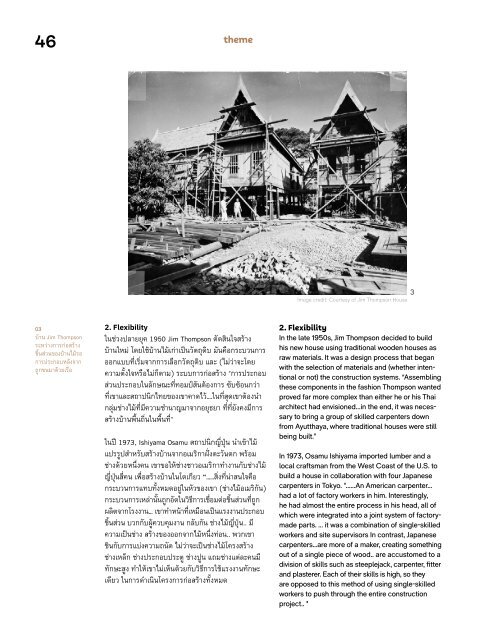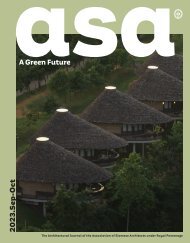ASA JOURNAL 14/2023
Create successful ePaper yourself
Turn your PDF publications into a flip-book with our unique Google optimized e-Paper software.
46<br />
theme<br />
Image credit: Courtesy of Jim Thompson House<br />
3<br />
03<br />
บ้าน Jim Thompson<br />
ระหว่างการก่อสร้าง<br />
ชิ้นส่วนของบ้านไม้รอ<br />
การประกอบหลังจาก<br />
ถูกขนมาด้วยเรือ<br />
2. Flexibility<br />
ในช่วงปลายยุค 1950 Jim Thompson ตัดสินใจสร้าง<br />
บ้านใหม่ โดยใช้บ้านไม้เก่าเป็นวัตถุดิบ มันคือกระบวนการ<br />
ออกแบบที่เริ่มจากการเลือกวัตถุดิบ และ (ไม่ว่าจะโดย<br />
ความตั้งใจหรือไม่ก็ตาม) ระบบการก่อสร้าง "การประกอบ<br />
ส่วนประกอบในลักษณะที่ทอมป์สันต้องการ ซับซ้อนกว่า<br />
ที่เขาและสถาปนิกไทยของเขาคาดไว้….ในที่สุดเขาต้องนำา<br />
กลุ่มช่างไม้ที่มีความชำานาญมาจากอยุธยา ที่ที่ยังคงมีการ<br />
สร้างบ้านพื้นถิ่นในพื้นที่"<br />
ในปี 1973, Ishiyama Osamu สถาปนิกญี่ปุ่น นำาเข้าไม้<br />
แปรรูปสำาหรับสร้างบ้านจากอเมริกาฝั่งตะวันตก พร้อม<br />
ช่างด้วยหนึ่งคน เขาขอให้ช่างชาวอเมริกาทำางานกับช่างไม้<br />
ญี่ปุ่นสี่คน เพื่อสร้างบ้านในโตเกียว “……สิ่งที่น่าสนใจคือ<br />
กระบวนการแทบทั้งหมดอยู่ในหัวของเขา (ช่างไม้อเมริกัน)<br />
กระบวนการเหล่านั้นถูกอัดในวิธีการเชื่อมต่อชิ้นส่วนที่ถูก<br />
ผลิตจากโรงงาน… เขาทำาหน้าที่เหมือนเป็นแรงงานประกอบ<br />
ชิ้นส่วน บวกกับผู้ควบคุมงาน กลับกัน ช่างไม้ญี่ปุ่น.. มี<br />
ความเป็นช่าง สร้างของออกจากไม้หนึ่งท่อน.. พวกเขา<br />
ชินกับการแบ่งความถนัด ไม่ว่าจะเป็นช่างไม้โครงสร้าง<br />
ช่างเหล็ก ช่างประกอบประตู ช่างปูน แถมช่างแต่ละคนมี<br />
ทักษะสูง ทำาให้เขาไม่เห็นด้วยกับวิธีการใช้แรงงานทักษะ<br />
เดียว ในการดำาเนินโครงการก่อสร้างทั้งหมด<br />
2. Flexibility<br />
In the late 1950s, Jim Thompson decided to build<br />
his new house using traditional wooden houses as<br />
raw materials. It was a design process that began<br />
with the selection of materials and (whether intentional<br />
or not) the construction systems. “Assembling<br />
these components in the fashion Thompson wanted<br />
proved far more complex than either he or his Thai<br />
architect had envisioned…in the end, it was necessary<br />
to bring a group of skilled carpenters down<br />
from Ayutthaya, where traditional houses were still<br />
being built.”<br />
In 1973, Osamu Ishiyama imported lumber and a<br />
local craftsman from the West Coast of the U.S. to<br />
build a house in collaboration with four Japanese<br />
carpenters in Tokyo. "......An American carpenter...<br />
had a lot of factory workers in him. Interestingly,<br />
he had almost the entire process in his head, all of<br />
which were integrated into a joint system of factorymade<br />
parts. ... it was a combination of single-skilled<br />
workers and site supervisors In contrast, Japanese<br />
carpenters...are more of a maker, creating something<br />
out of a single piece of wood.. are accustomed to a<br />
division of skills such as steeplejack, carpenter, fitter<br />
and plasterer. Each of their skills is high, so they<br />
are opposed to this method of using single-skilled<br />
workers to push through the entire construction<br />
project.. "


















